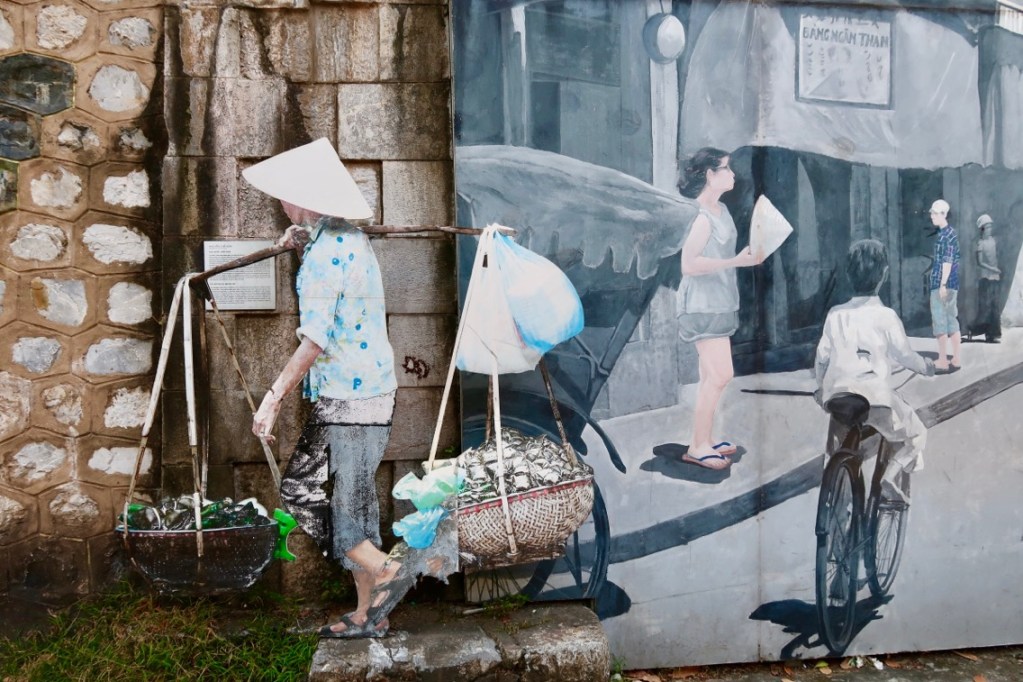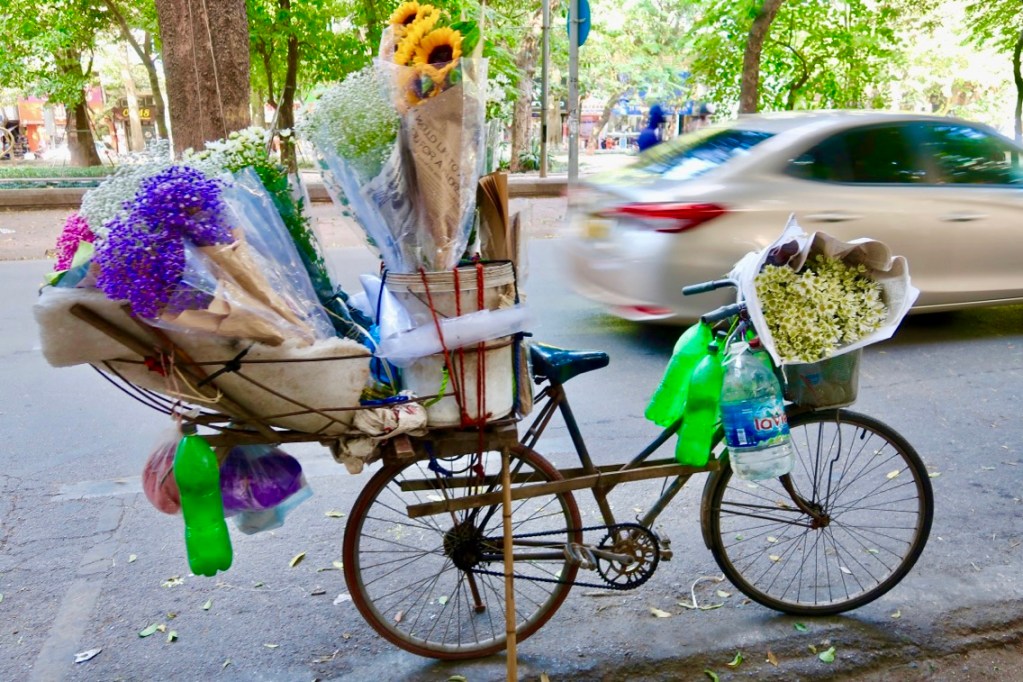Getting A Tailor-Made Áo Dai Dress, The Traditional Vietnamese Dress In Hanoi, Vietnam



































































Getting A Tailor-Made Áo Dai Dress, The Traditional Vietnamese Dress In Hanoi, Vietnam
As I walked the streets of Hanoi, I stopped to admire the hand-painted silk dresses and the beautifully embroidered sheer fabrics.
Many women on the streets were wearing these beautiful long flowing dresses, stopping to have their photos taken by the lake.
I had tried on some of these traditional dresses, but none of them fit me very well.
They were all either too tight at the bust, or at the arms, or at the neck.
I even stopped in some shops on our long walks that had a large selection of dresses, but was told that this was not a dress shop, but an embroidery shop where women bring their plain colored dresses to get hand embroidered with beautiful designs.
Two talented people were sitting on the floor, hand stitching each flower and leaf.
These dresses cannot be bought off the rack, as each women has a slightly different height, bust, butt and curves.
When a woman wants a traditional dress, she selects the fabric that she likes, and then she gets measured for a handmade dress.
I did not intend to get a tailor-made dress, but at one store I admired a fabric, and before I knew it, I was pulled in by a smiling woman with an iron grip on my arm.
Her father was laying on a wooden platform in the back of her store, among the daily groceries and piles of colorful fabrics.
He seemed to have suffered a stroke, and was recovering in the back of her shop, as she was hustling to make enough money to support her family and elderly parents.
Suddenly, getting a tailored traditional Vietnamese dress seemed like a very good idea, even if I would have very few opportunities at home to ever wear it….
The woman took my measurements in a hurried way, almost trying to ensure that I would not change my mind and walk away.
She wrote the numbers haphazardly on her piece of paper, which made me worry that the final dress would have the wrong shape, with too long arms, too tight a neck and the wrong bust, hips and waistline.
I have a good reason to be concerned about buying a tailor-made dress in Vietnam.
I once was measured for a summer dress in Ho Chi Minh city, and two days later I picked up a dress so big, it could have been a parachute.
But this lady in Hanoi promised that the dress would fit perfectly and be comfortable.
And in three days, she did deliver on her scooter to my hotel, a perfectly fitting Ao Dai dress, which is very comfortable to wear.
The Ao Dài is a traditional Vietnamese dress that is intertwined with the history of Vietnam.
It is a long tunic split on both sides, and it is worn over wide legged trousers.
In Vietnamese, Áo, means “a shirt” and Dài means "long."
The dress in its current form was invented in the 18th century and has changed only slightly through the 19th and early 20th centuries.
China occupied Vietnam for over 1,000 years (111 B.C. to A.D. 938.)
Throughout all those years of occupation, the Vietnamese had managed to keep their own language and traditions.
For centuries, peasant women typically wore an undergarment called “Yếm” underneath a blouse or an overcoat, alongside a skirt.
Unlike other Vietnamese clothing that helped to segregate the classes, the unseen Yếm were worn by Vietnamese women of all walks of life, from peasant women toiling in the fields to imperial consorts.
Aristocrats favored a cross-collared robe as a top dress, which became popular during the Confucian era.
When the Ming Dynasty occupied Vietnam in 1407, it forced the Vietnamese women to wear Chinese-style pants.
The following Lē Dynasty required women to dress in the Confucian dress form, but only enforced the dress code haphazardly, so skirts and halter tops remained the norm.
During the 17th and 18th centuries, Vietnam was divided into northern and southern territories, with the Nguyen Lords ruling the south.
To distinguish the southern people from the northerners, in 1744, the lord of Hue decreed that both men and women of his court must wear trousers and a gown with buttons down the front.
The members of the southern court were thus distinguished from the courtiers of the Hanoi lords, who wore long tunics with long skirts.
The Áo Dai that is worn nowadays, was created by Lord Nguyễn Phúc Khoát based on the Chinese Ming Dynasty costumes.
In the 19th century, the traditional Áo Dai dress was called “The five part dress.”
It had two flaps sewn together in the back, two flaps sewn together in the front, and a "baby flap" hidden underneath the main front flap.
The gown appeared to have two-flaps with slits on both sides, which is how the Áo Dai looks today.
Compared to a modern Áo Dai, the front and back flaps were much broader and the fit looser, and the tunic was much shorter.
It had a high collar and was buttoned in the same fashion as a modern Áo Dai, either sideways down from the neck or at the back.
Women wore the dress with the top few buttons undone, revealing a glimpse of their Yếm underneath.
The Áo Dai was worn as a uniform by girl students in the early 20th century.
The dress style was promoted by fashion designers and artists and was a success at the Paris fashion shows in the 1920’s.
It was adopted as a national costume for the modern era.
The Áo Dai became very popular among the people from 1960 to 1975.
A brightly colored “Áo Dai Hippy” in psychedelic patterns was introduced in 1968.
A version designed for practical use and convenience with slits that extended above the waist and panels that reached only to the knee followed, and became popular among working women.
The Áo Dai has always been more popular in the South than in the North.
The communists, who gained power in the North in 1954 and in the South in 1975, had conflicted feelings about the Áo Dai.
They praised it as a national costume, but Westernized versions of the dress like the Hippy Áo Dai, were considered "decadent" in the Saigon of the 1960s and early 1970s, and were condemned.
In the years that followed, the Chinese communist regime looked down on refinement and fashion, and no longer valued any cultural heritage, including their own.
Economic crisis, years of famine, and war with Cambodia, all combined to make the 1980s a fashion low point.
The Áo Dai was rarely worn except at weddings and formal occasions, with the older, looser-fitting style preferred.
Overseas Vietnamese, meanwhile, had kept the tradition alive with "Miss Ao Dai" pageants, the most notable one held annually in Long Beach, California.
The Áo Dai experienced a revival beginning in the late 1980s, when state enterprises and schools began adopting the dress as a uniform again.
In 1989, 16,000 Vietnamese attended the Miss Ao Dai Beauty Contest held in Ho Chi Minh City.
In 1995, the Miss International Pageant held in Tokyo gave its "Best National Costume" award to the Áo Dai.
It was honored as Vietnam's "National Soul."
In Hanoi, tourists get fitted for Áo Dai dresses along Luong Van Can Street. (Exactly where my tailor grabbed my hand and later made me a well fitting Áo Dai.)
If you continue north on this road, it will lead you to Mural Street, featuring Hanoi artists who painted murals of life in Hanoi, along the old train bridge.
The elegant city of Hue, located in the central region, is known for its Ao Dai Dresses and for the traditional leaf conical hat, as well as for its well-dressed women.
The Áo Dai is now a standard dress for formal occasions and for wedding ceremonies and other celebrations.
We saw women wearing their Áo Dai and buying bouquets of flowers, just to get their photos taken by the lake or by a pagoda or at any other pretty spot around the city.
The most popular style of Áo Dai worn today fits tightly around the wearer's upper torso, emphasizing her bust and curves.
Although the dress covers the entire body, it is thought to be provocative, especially when it is made of thin fabric.
"The Áo Dai covers everything, but hides nothing," is a traditional local saying.
The dress must be individually fitted and usually requires several weeks for a tailor to complete, but most tourists do not spend that much time in busy Hanoi.
The tailors now make the dress in three days, if you choose a fabric that is already embroidered or a pattern that does not require embroidery.
The tailor-made Ao Dai cost me $60 and it fits me well.
If you are planning to be in Hanoi, why not get yourself fitted for a unique traditional Vietnamese dress ?
(They do make them for men also, but they look like Ming Dynasty robes.)
From Hanoi with love,
Tali